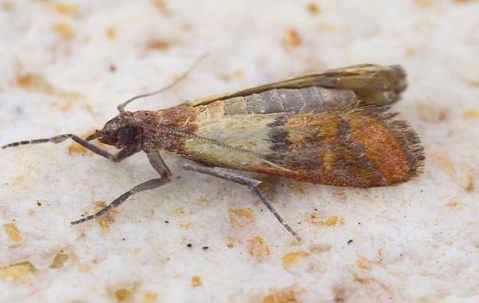No one wants to find bugs in their breakfast. But this is a problem Quad Cities residents sometimes have to face. Indian meal moths are pantry pests that infest food items and they can become a huge issue should they get introduced into your home. In most cases, infestations usually start at the food manufacturing facility where food products were originally processed. Food processing facilities then ship these contaminated food items to stores, where people purchase them and bring them home.
How to Tell if You Have an Indian Meal Moth Infestation
Indian meal moths are small, oval-shaped, and have wings that are gray and bronze in color. These insect pests originally got their name when they were found in a meal made of “Indian corn.” Spotting adult Indian meal moths flying around in your home is a good indicator that you already have a mature pantry pest infestation. If you start seeing eggs and larvae in your flour, cereal, or rice packages, you should throw those food items away immediately.
Indian Meal Moth Life Cycle
Female Indian meal moths lay between 60 and 400 microscopic eggs on the surface of a food item. Products often targeted are cake mixes, rice, pasta, and other grains. The eggs usually hatch within 2 to 14 days. Once the eggs hatch, the larvae stage begins and lasts for 2 to 41 weeks, depending on the temperature. During this stage, larvae crawl around and feed on the food item they hatched in, as well as other grains in your pantry. The larval stage is where Indian meal moths do the most damage. Adult Indian meal moths do not have developed mouth parts and therefore don’t eat anything. It is the larvae that contaminate foods.
Pantry Pest Prevention Tips
It’s important to remember that Indian meal moths are difficult to prevent, and no DIY prevention method is effective 100% of the time. However, there are still a few ways you can prevent these pantry pests from contaminating your food.
Store dry food products in plastic containers rather than the packaging they came in. Indian meal moth larvae can chew through bags and cardboard boxes and potentially spread to more food items.
Inspect all dry goods at the store before purchasing them.
Check bags and boxes for small holes where Indian meal moth larvae have chewed through.
Invest in professional pest control
Removing a pantry pest problem from your Quad Cities home is difficult without professional help. Quik-Kill Pest Eliminators has the skill, equipment, and knowledge you need for a pest-free home. For assistance with your pest control problem, don’t hesitate to reach out to the licensed pest technicians here at Quik-Kill.

